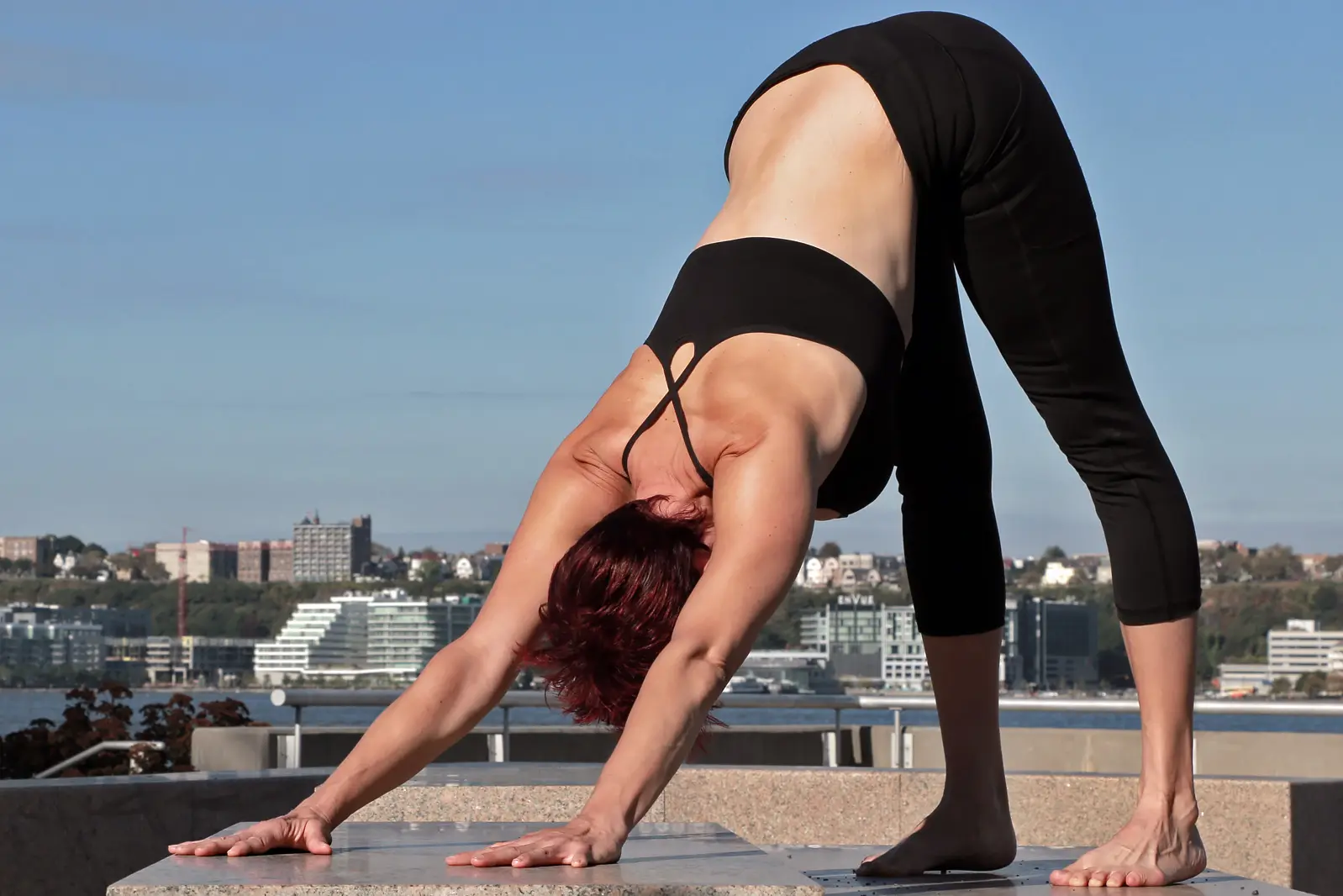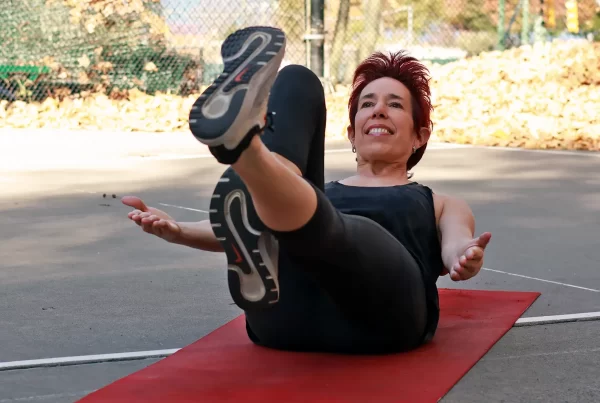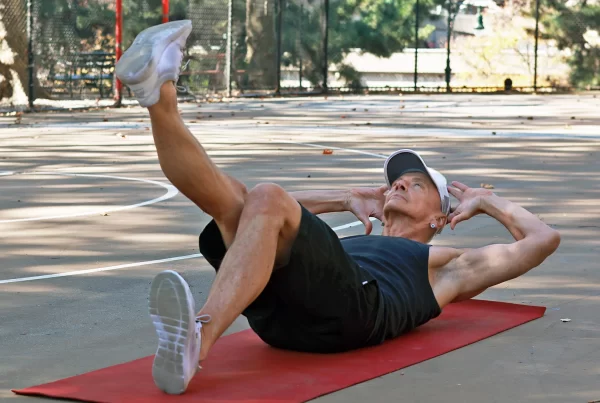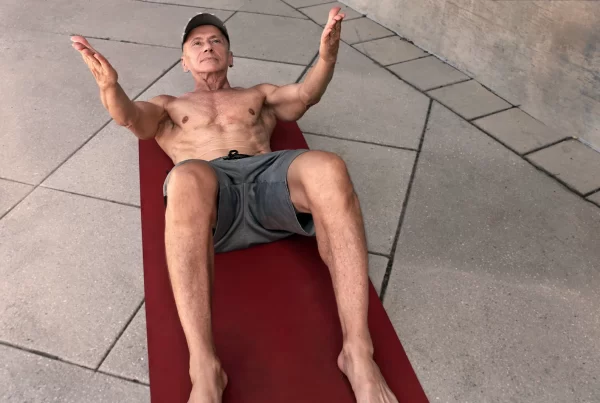Downward Facing Dog

Catch Your Breath and Reset Your Body – Downward Facing Dog
Downward Facing Dog is probably one of the most well-known, iconic poses in yoga, and even if you have never attended a yoga class, you’ve probably heard about Down Dog.
This pose serves as a mild inversion and a shoulder strengthening exercise, stretching the entire posterior chain, including the typically tight hamstrings and calves. It lengthens the muscles along the spine and provides a solid workout for the arms and shoulders. Traditionally, you can find Downward Facing Dog in Sun Salutations and the Vinyasa Flow, which is often used as a point of pause during Vinyasa or Ashtanga yoga practices. The Sanskrit name is ‘Adho Mukha Svanasana’ because it resembles a dog stretching, and while it may appear simple, it has many functions, benefits, alignment cues, and muscles, making it both a rejuvenator and relaxer at the same time.

What Can Downward Facing Dog Do for You?
- Downward Facing Dog teaches you to stay in the present and learn how to manage stressful situations through breathwork without being married to the outcome. This pose is incredibly beneficial for athletes, as it helps them maintain concentration during any activity, be it weightlifting at the gym, attempting a dunk in basketball, or powering through a high-intensity interval during a HIIT workout.
- Downward Facing Dog is the perfect balance of strength and flexibility, which allows you to max out your fitness and give it your all during a training session.
- Downward Facing Dog can help correct imbalances in strength and flexibility, reducing aches and pains and the risk of injury.
- Downward Facing Dog is a powerhouse pose that strengthens and stretches the body in many ways. It complements your regular training routine by keeping your muscles strong, resilient, and limber.
- Like in any inverted yoga pose, Downward Dog facilitates the natural upward movement of the diaphragm. This helps you deepen your breathing and increase oxygen intake, which sustains your energy during workouts.
The Most Important Alignment Cues
– Make sure your hands are shoulder-width distance apart and that the weight is evenly distributed throughout your entire hand.
– Your feet are hip-width distance apart and parallel to each other, letting the heels reach towards the floor.
– Keep your spine straight and lift the hips up high so you look like an inverted V.
– Push the floor away with your hands, externally rotate your upper arms, and let the shoulders slide down the back.
– Keep in mind that the neck is part of the spine (cervical spine), even though we often forget that, so make sure your head and neck are in line with the rest of your spine.
– Close your ribcage and pull the belly button towards the spine.
– Engage your quads and keep your legs active.
The Rewards You Can Expect
– Downward Dog boosts energy.
– Improves circulation.
– Builds incredible upper body strength.
– Increases flexibility on the backside of your body.
– Improves brain health.
– Gets things moving.
– Boosts memory power.
– Clears your head in more than one way.
– Counteracts slumpy posture syndrome.
– Makes your skin glow.
– Melts away stress and calms the nervous system.
– Relieves fatigue, back pain, insomnia, and headaches.
– Allows for a healthy pause.
Typically, you enter Downward Facing Dog on an exhalation. But since it is often used as a pause in a dynamic flow, it also presents an opportunity for a brief meditation focused on your breathing. Inhale and exhale slowly through your nose, letting each breath deepen naturally. Remember, the depth and quality of your breathing are mirrored in your pose. By taking a moment in Down Dog to truly connect with your breath, you’ll find it enhances your overall practice.
Newbies – Be Aware of What You’re Doing
Downward Facing Dog is considered the resting point in a Vinyasa Flow. Yet, for those new to yoga, it may present a challenge, and achieving a state of restfulness in this position can take several sessions. The good news is that the better you understand the anatomy of Downward Dog, the better you will be able to perform it.

MUSCLES INVOLVED IN DOWNWARD FACING DOG:
SHOULDER ANATOMY
The shoulders and arms get the most of a workout in Downward Facing Dog and, with that, are also easily prone to injury, particularly the rotator cuffs, a group of four muscles that surround the shoulders. These four rotator cuff muscles are the supraspinatus, infraspinatus, subscapularis, and teres minor. They all originate at the shoulder blade and insert into the upper arm bone. The subscapularis is located underneath the scapula, the supraspinatus sits on top of it, and the infraspinatus sits below the spine of the shoulder blade.
If you are new to Downward Facing Dog or have tight shoulders, you may notice that your arms tend to internally rotate, and you may even have to bend your elbows. Maintaining an external rotation of the upper arms leads to a contraction of the infraspinatus and teres minor, which opens up the area of your collarbone.
ANATOMY OF THE SPINE
Even though all the muscles along the spine get lengthened and stretched in Downward Facing Dog, the main focus is on the thoracic spine in between the scapulae. The range of motion in this region of the spine is somewhat limited, which is why Down Dog is so important to relieve some of the muscle tension that can build up in this particular area. More specifically, the latissimus dorsi, teres major, and posterior deltoids get a thorough stretch.
So, the key focus of Downward Dog in terms of the spine is to open up the upper back and improve our posture, which ultimately makes our everyday movements more natural and easier. It will also help us to hold ourselves up straighter and carry ourselves with more confidence in our day-to-day lives.
ANATOMY OF THE CORE
Downward Facing Dog lengthens the obliques and intercostal muscles – which are a part of the core muscles and located in between the ribs – while at the same time working the transversus abdominus by pulling the belly button towards the spine.
In yogic language it means that we are engaging the Uddiyana Bandha, one of the energy locks in our body, that strengthens the abs and helps us to more easily practice any kind of pose.
ANATOMY OF THE LEGS
As far as the legs are concerned, the hamstrings, gluteus maximums, and gastrocnemius get a thorough stretch while the quadriceps muscles are engaged and have to work. Additionally, the adductor muscles – your inner thighs – get a workout, and you want to feel like you are squeezing a block between your legs. The stretch in your calf muscles and the lengthening of your Achilles tendons increases the more that you are able to flex your ankles and let your heels sink towards the floor.
A lot of people have to deal with tight hamstrings and calves as well as restricted range of motion in the ankles, so the more you practice Downward Facing Dog, the more subtle the muscles and tendons in your legs and ankles will become, and, with that, you can improve any kind of sports performance you do outside of yoga.
Don’t Do Down Dog When…
While Downward Facing Dog comes with a ton of benefits, you should be cautious if you are dealing with carpal tunnel syndrome or suffer from hypertension (high blood pressure). Additionally, pregnant women should also refrain from practicing this pose during the later stages of pregnancy.
For some, Downward Facing Dog is all about opening up, stretching and relaxing, for others it’s a method to learn to engage muscles for joint stabilization. But however way you look at it, ultimately Down Dog is all about utilizing the strengths of your arms and legs to fully and evenly stretch out the back side of your body.
Enjoy exploring the Downward Dog pose as an opportunity to discover more about your body and yourself.







One Comment